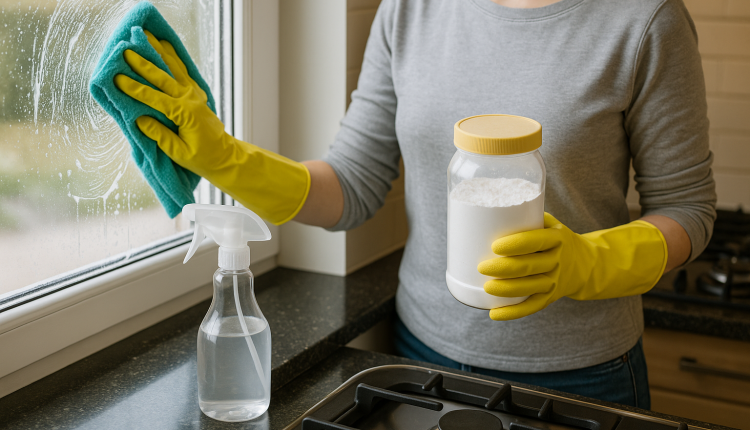Cornstarch Cleaning Hacks: The Secret Weapon for Sparkling Glass and Grease-Free Kitchens
In the world of natural cleaning solutions, a humble pantry staple is quietly gaining a reputation as a powerful, non-toxic alternative to harsh chemical cleaners. That staple? Cornstarch. Known primarily as a thickening agent in cooking, cornstarch has surprising and highly effective cleaning abilities—particularly when it comes to leaving glass and mirrors crystal-clear and removing greasy residues from kitchen surfaces.
If you’ve been searching for a budget-friendly, eco-conscious, and highly efficient cleaning solution, look no further than the box of cornstarch in your cupboard. This article explores how and why cornstarch works, what makes it so effective, and how to incorporate it into your regular home-cleaning routine.
Why Cornstarch Works as a Cleaning Agent
Cornstarch is made from the starchy part of corn kernels and is composed primarily of carbohydrates. When mixed with water or other simple ingredients, it forms a smooth, non-abrasive paste or spray that can lift dirt, absorb grease, and polish surfaces.
There are three primary reasons cornstarch is so effective:
- Absorbent Properties: Cornstarch is excellent at soaking up oils, grease, and moisture, which makes it ideal for use on oily kitchen surfaces or fingerprint-laden glass.
- Non-Streak Finish: Unlike many commercial cleaners that contain surfactants or alcohol, cornstarch leaves behind no residue. This results in an ultra-clear, streak-free finish on glass, mirrors, and even stainless steel.
- Gentle on Surfaces: Cornstarch is non-toxic and non-abrasive, which makes it suitable for delicate surfaces that might be scratched or damaged by harsher substances.
How to Use Cornstarch to Clean Glass and Mirrors
Traditional glass cleaners often leave behind streaks or smudges, especially in humid environments or when too much product is applied. Cornstarch, when used correctly, provides a clean that is both satisfying and crystal-clear.
DIY Cornstarch Glass Cleaner Recipe
You’ll need:
- 2 cups of warm water
- ¼ cup of white vinegar
- 1 tablespoon of cornstarch
- A spray bottle
- A microfiber cloth or newspaper
Instructions:
- In a bowl, mix warm water with vinegar and cornstarch until the powder dissolves completely.
- Pour the mixture into a clean spray bottle and shake well before each use (the cornstarch may settle at the bottom).
- Spray the solution directly onto glass or mirrors.
- Wipe clean with a microfiber cloth, paper towel, or balled-up newspaper for a lint-free finish.
Tips:
- Always shake the bottle before each use to prevent the cornstarch from settling.
- For best results, avoid cleaning glass in direct sunlight to prevent premature drying and streaks.
Using Cornstarch to Remove Grease from Kitchen Surfaces
Grease build-up on stovetops, countertops, and even cupboard doors can be stubborn and hard to remove. Cornstarch excels at tackling grease because of its absorbent nature. It binds to oily particles, lifting them from surfaces with minimal scrubbing required.
Cornstarch Degreasing Paste
You’ll need:
- Cornstarch
- Water
- A small bowl
- A sponge or soft cloth
Instructions:
- Mix equal parts cornstarch and water to form a paste.
- Apply the paste to greasy surfaces such as stovetops, backsplashes, or range hoods.
- Let it sit for 10–15 minutes. The cornstarch will begin to absorb the grease.
- Wipe away the paste using a damp sponge or cloth.
- Rinse the area with warm water and dry with a clean towel.
For light, fresh grease stains, you can sprinkle dry cornstarch directly onto the area, let it sit for a few minutes, and then wipe clean.
Other Household Uses for Cornstarch
Cornstarch’s versatility doesn’t stop at glass and grease. Here are a few bonus ways you can use it around the house:
- Carpet Cleaning: Sprinkle cornstarch on carpets to absorb odors and light stains. Let it sit for an hour and vacuum thoroughly.
- Window Tracks: Combine cornstarch with baking soda and a bit of water to scrub grimy window tracks.
- Polishing Silver: Create a paste of cornstarch and water, apply it to tarnished silverware, let it dry, then buff clean for a sparkling shine.
- Deodorizing Shoes: Sprinkle some cornstarch into shoes to absorb moisture and odors overnight.
Eco-Friendly, Safe, and Affordable
One of the most appealing aspects of using cornstarch as a cleaning solution is its safety profile. It is completely non-toxic, making it ideal for homes with pets, children, or anyone sensitive to chemical fumes. There’s no need to worry about ventilation or protective gloves when cleaning with cornstarch.
It’s also environmentally friendly. Unlike many commercial cleaning products, cornstarch won’t pollute waterways or contribute to indoor air pollution. Plus, it’s biodegradable and safe to rinse down the drain.
In terms of cost, a box of cornstarch is inexpensive and goes a long way, especially when used sparingly for targeted cleaning tasks. Compared to the growing cost of specialty cleaners, cornstarch is a true budget-friendly alternative.
Final Thoughts
Cornstarch may not be the first thing that comes to mind when you think of cleaning your home, but once you try it, it might just become your go-to for glass and kitchen grime. It’s safe, affordable, and remarkably effective.
Whether you’re dealing with greasy splatters on your stovetop or a mirror that just won’t come clean without streaks, cornstarch offers a surprisingly elegant solution. By embracing simple, natural cleaning methods, you’re not only creating a cleaner home—you’re contributing to a healthier environment and making your household routine more sustainable.
So the next time you reach for a cleaner, consider reaching into your pantry instead. Your glass will gleam, your kitchen will shine, and your wallet—and the planet—will thank you.

